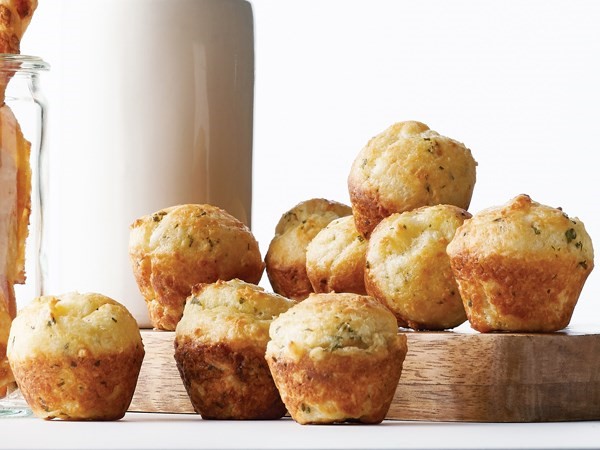Description
Gluten is a protein found in wheat, barley, and rye. Unfortunately, if someone has celiac disease or a gluten-intolerance, they are not able to digest this protein. Since most flour is made from wheat, those following a gluten-free diet must seek out alternatives. Enter the gluten-free flours.
White Rice Flour
White rice flour is one of the most common gluten-free flours due to its mild flavor and texture similar to traditional all-purpose flour. It comes in varying granule sizes: regular and superfine. Superfine rice flour tends to reduce grittiness in the final baked good.
Related Content, undefined
Homemade Gluten-Free All Purpose FlourGlutinous or Sweet Rice Flour
Milled from sticky rice, also called sweet Japanese rice (and sometimes labeled as mochiko), this high-starch rice flour retains the chewiness of baked goods and works well as a flour substitute for bechamel sauce. Sweet rice flour can also preserve the integrity of the baked good by preventing the item from going stale too quickly. Use it to make chewy cookies, brownies, and bars.
Brown Rice Flour
Brown rice flour is a whole grain, meaning that it's milled with the hull, bran, and germ. Due to the milling process, it contributes the most grittiness in a final baked good. When baking with this flour, it's important to let the batter or dough rest in order to absorb more water and hydrate the granule. Use it in recipes that feature brown sugar and nutty or caramel flavors, like carrot cakes, banana muffins, or as a thickener in rich and silky butterscotch pudding.
Oat Flour
Finely ground gluten-free oats—that's the gist of oat flour. When paired with other flours, it can help reduce graininess in baked goods. Oat flour is best used to complement caramel, nut, brown sugar, honey, maple sugar, blueberry, banana, coffee, and coconut flavors.
Cornmeal
Typically used to make cornbread or grits in the United States, cornmeal is rougher in texture but can come in different grind sizes. Make sure to give cornmeal proper time to hydrate (let rest 30 minutes after all ingredients have been incorporated) to reduce grainy textures. Since corn meal has a larger granule size than corn flour, use it to create corn bread, corn cakes with berry compotes, or cheesy polenta.
Corn Flour

The big difference between cornmeal and corn flour is the granule size. Corn flour is a very finely ground cornmeal (not to be confused with cornstarch) that appears powder-like. Due to its fine grain size, corn flour tends to absorb water faster than cornmeal. Finely milled corn flour is a perfect ingredient to make dense cakes, cobblers, biscuits, scones, or fritters.
Buckwheat Flour

Famous as being the primary ingredient in soba noodles, this Japanese grain contains robust, assertive earthy flavors. The grain's flour form is a hearty-tasting substitute for all-purpose flour in pancakes, muffins, waffles, and breads. When baking with this flour, consider pairing it with a mild-flavored flour, such as rice flour or sorghum flour, to provide balance.
Teff Flour
Milled from a gluten-free grain native to North Africa, this whole grain flour has a sandy appearance and mimics flavors of Thai tea and scalded milk. Replace about 25 percent of gluten-free all purpose flour with Teff flour for a deeper flavor—one that pairs well with chocolate, nuts, dark fruit, flax seeds, and coffee.
Sorghum Flour
Growing in popularity, sorghum is a mild tasting cereal crop that can be used to replace regular wheat flour. It has a slightly sweet aroma that pairs well with butter, berries, pecans, dates, figs, peanuts, ginger, cinnamon, aniseed, and nutmeg. Malted sorghum is also a popular choice for gluten-free beer makers, as a replacement for malted barley.
Coconut Flour

Although coconut flour is all the rage these days, what most people don't know is that it absorbs nearly four times its weight in liquid. That means unless you add extra liquid, your batter will seem thicker than normal. That's why coconut flour is used more like a functional ingredient and does not replace traditional all-purpose flour in a ratio of 1:1. However, if you like the slight coconut flavor as much as we do, try using small amounts in tropical-flavored baked goods.
Almond Meal and Almond Flour

Commercial almond meal and almond flours are blanched to remove the skin. Then it's ground into different sizes. Almond meal is ground less and has a larger particle size than almond flour. Pro tip: If you need a particular granule size for a recipe, purchase almond meal and use a food processor or blender to pulse to desired size.
Tapioca Flour
Made from the tropical cassava root, tapioca flour is a starchy, slightly sweet flour that aids in thickening by binding water within batters. Tapioca flour can be used sparingly on its own to thicken soups, sauces, and pie fillings, but is also wonderful when added to gluten-free mixes.
Hyvee Culinary Expert Tip
When substituting flour as a thickener, use 2 teaspoons of tapioca flour for every 1 tablespoon of flour.Potato Flour
Not to be confused with potato starch, potato flour is made from whole peeled potatoes that are dried and powdered. Potato flour acts like a thickener for sauces, gravies, and soups, and is an excellent addition to yeast breads. When mixed with other gluten-free flours for baked goods, it can help provide a more tender crumb.
Quinoa Flour
Made by grinding quinoa, this flour has a strong, robust, and slightly bitter flavor. In baked goods, it can create a tender, moist crumb, but it's best when combined with other gluten-free flours. Try replacing 25 to 50 percent of your gluten-free flour mixture with quinoa flour to make muffins, pancakes, scones, and breads.


